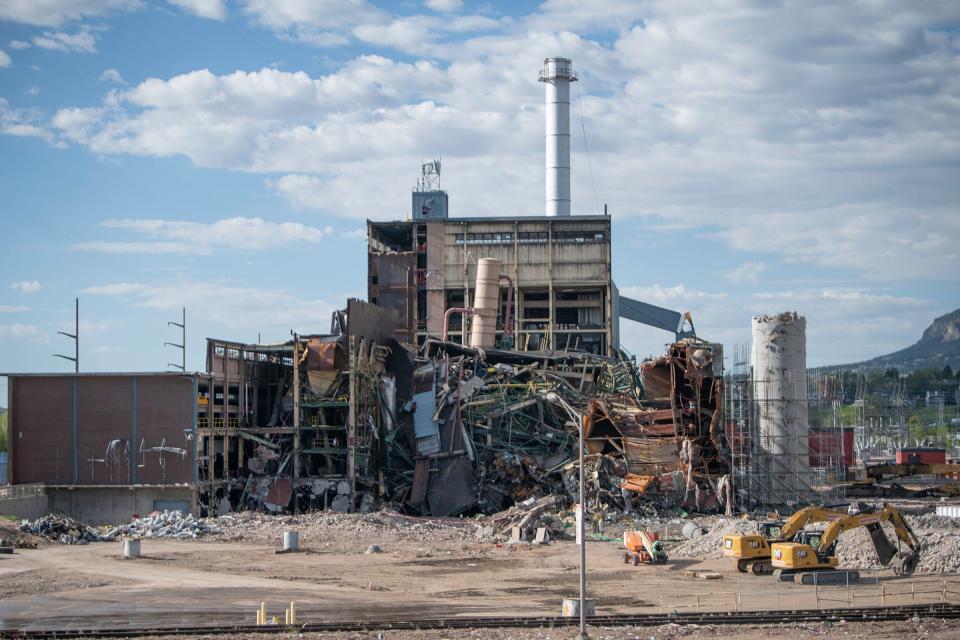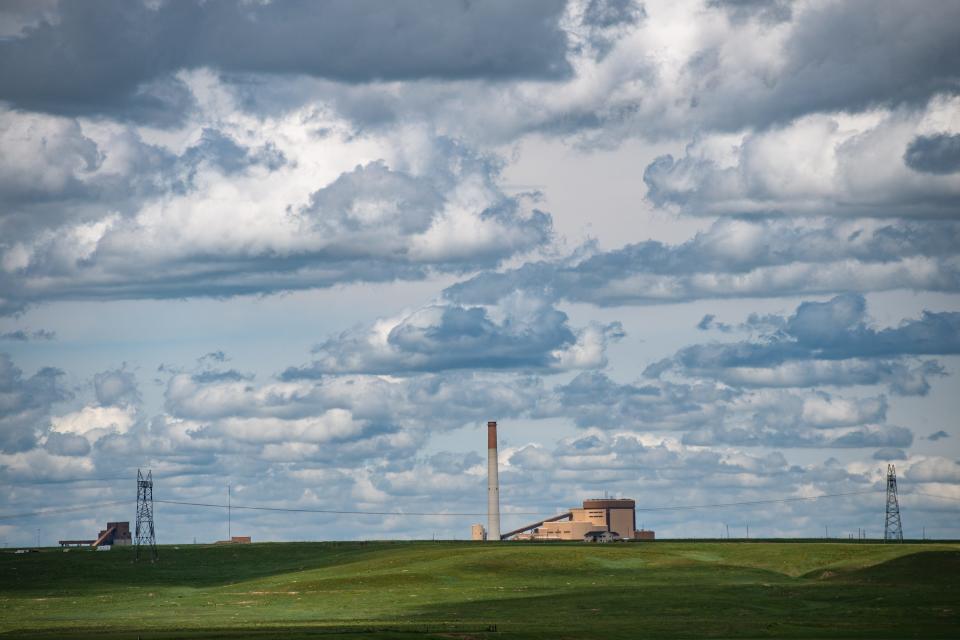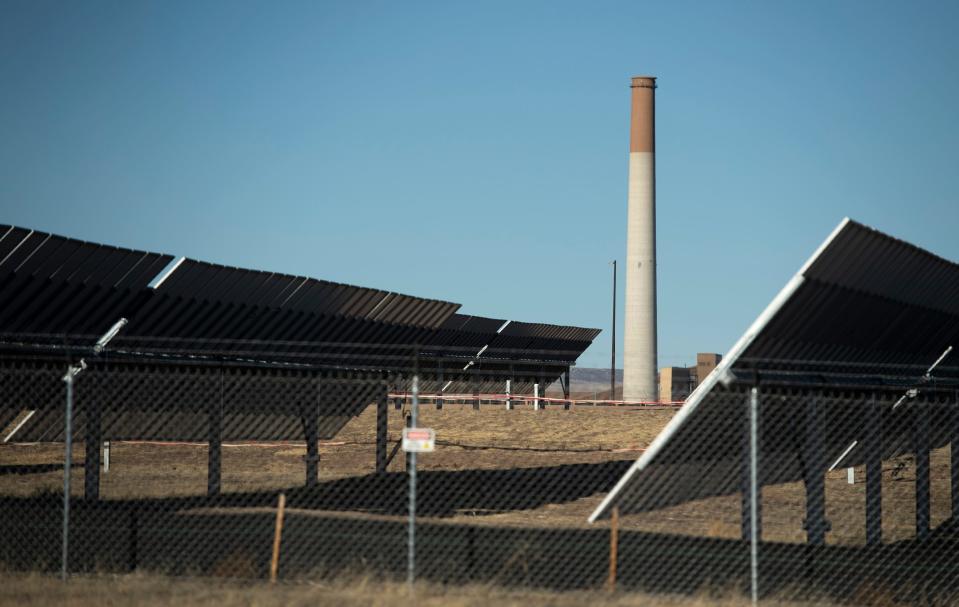These power plants are Colorado's biggest greenhouse gas emitters. Here's where they stand
Over the past decade, the 10 largest emitters in Colorado contributed to an outsized share of greenhouse gasses — and every single one is a fossil fuel power plant.
A Coloradoan data analysis of the Environmental Protection Agency’s greenhouse gas reporting program found that these facilities contributed to one-fifth of the state’s emissions in 2020.
Parent companies of the power plants are facing regulatory pressure to reduce their emissions. And while some have been hit with heavy fines for environmental violations, the sector as a whole decreased its emissions by about 22% during the time period analyzed.
More details about our methodology can be found here.
In 2019, the state adopted nation-leading targets for emissions reductions, and since then, more legislation has been added to curb the pollution, said Katie Schneer, an analyst that focuses on climate policy at the Environmental Defense Fund.
One of Colorado’s goals is to halve emissions by 2030 (relative to 2005 levels).
As part of this effort, the six major utilities in the state are mandated to reduce emissions by at least 80%. Modeling results presented by the Colorado Department of Public Health and Environment show the electric power sector is projected to meet those goals.
But these efforts are not enough for Colorado to achieve its economy-wide objective. Schneer said the recently released Roadmap 2.0 shows the state is not just off track based on current policy, but “it also shows that even if all of the actions proposed in the roadmap were fully implemented and achieved … they still wouldn’t put the state on track for its targets.”
The Coloradoan reached out to each of the parent companies that own the largest emitting facilities and talked to sources including different state departments to better understand the progress and challenges in tackling the emissions that cause climate change.
‘Millions of decisions’
The same modeling results that show the electric power sector on-track for its targets, show the sector that is off by the largest margin is transportation.
“One thing that we talked about a lot that makes transportation somewhat unique in this conversation is that our system is built upon millions of decisions that millions of people make every single day about how they're going to get around,” Colorado Department of Transportation communications director Matt Inzeo said.
Decisions like switching to an electric vehicle, taking a bus or walking can add up, and the state is working on making those options more comfortable and convenient for people to take, Inzeo said.
For example, there’s a combination of consumer incentives like tax credits for electric vehicles and bikes, requirements on a minimum of EV sales for car manufacturers, as well as investment in infrastructure to expand the charging network, Colorado Energy Office Executive Director Will Toor said.
But unlike with utilities, there’s not a statutory emission reduction target for this sector.
“When it comes to building and transportation … those take a different set of strategies. You can’t just pass a regulation and say, ‘everybody shall do this.’ Instead, what you really need is market transformation,” Toor said.
But Schneer says the state’s roadmap relies heavily on voluntary action and incentives.
“One type of policy that is really critical that has been missing is having limits in place on the overall pollution across all major emitting sectors including the electric power sector, transportation sector, building sector, and so on,” Schneer said.
The data show the areas driving the greatest cuts in pollution are the ones where there’s enforceable requirements, she said.
“What that underscores is a strong track record of results from policies that directly regulate the pollution that’s causing climate change,” Schneer said.
A bridge to renewable energy
The companies that own the 10 largest emitting facilities all have plans to shut down their coal plants.
For example, Colorado Springs Utilities closed the Martin Drake plant in 2022, and Platte River Power Authority’s Rawhide Energy Station in Larimer County will be retired by 2030.

The last coal plant in the state to close will be Comanche Unit 3 in Pueblo, which is required to close no later than Jan. 1, 2031. After that, there’ll be no coal generation in the state, Toor said.
“Generally speaking, you're seeing a slight transition from coal, but that transition is mostly to gas-fired power generation,” said Ryan Maher, a staff attorney at the Center for Biological Diversity.
Maher, does not endorse gas as a bridge towards renewables, and said the transition needed to be quicker.
“Even when you’re relying on gas, they’re still huge contributors to greenhouse gas emissions,” Maher said, and pointed out that three of the top-10 polluters found in the Coloradoan analysis are gas-powered plants: Cherokee, Fort St. Vrain and Rocky Mountain Energy Center.
“When you invest in new infrastructure, the plan is to use it for decades. We don’t have decades when it comes to climate change. The bridge needed to be much shorter to be actually useful,” Maher said.
Some of the companies said, over email, that they’re keeping gas in their portfolio to maintain affordability and reliability during the transition:
“Moving forward, we are carefully expanding our portfolio of renewable resources, to include battery energy storage. However, to best manage our customers’ costs and to ensure the reliability of our electric grid, natural gas-based generation will continue to serve as a key part of our bridge strategy,” said Steve Berry from Colorado Springs Utilities.
“Strategically, we use natural gas units to maintain system reliability when renewable wind, solar and storage alone can’t support customer demands as we transition to a carbon-free system,” said Tyler Bryant from Xcel Energy.
Earlier this year, the Coloradoan reported on how Platte River Power Authority is facing pressure to add interim reduction targets like the other major utilities have done, but the company said, “our largest carbon-emitting resource, Rawhide Unit 1, is also our least-cost, most reliable resource that is necessary through 2029 to maintain reliability and financial sustainability as we make this transition. This makes it extremely difficult to commit to an interim goal without sacrificing reliability and financial sustainability.”
To be clear, some companies also said they are adding battery storage as a way to tackle the weather intermittency periods.

Impacts on public health
Ean Tafoya, the Colorado State Director at GreenLatinos, said the Cherokee gas smokestack (which used to be coal) is visible from his mom’s front yard.
Together with other advocacy groups, they protested at Xcel's headquarters to get the early closure of Comanche Unit 3, which was originally supposed to close in 2070, and while he agrees utilities are moving in the right direction, he said more work is needed.
“We have to be moving faster to more sources of clean energy because even with natural gas-fired plants, that natural gas comes from somewhere and all along from extraction to the midstream of transporting it to the burning of it, causes toxics to be released into the community,” Tafoya said.
Some of the companies, like Xcel Energy and Platte River Power Authority, that plan to use gas to generate electricity also said they could eventually switch that to hydrogen. But the false promise in this, Maher said, is that gas can still be used to produce hydrogen in the first place.
Maher said these emissions not only fuel climate change but can also contribute to the ozone problem in the Front Range, negatively impacting the public’s health — particularly for vulnerable populations like children and the elderly, as well as disproportionately impacted communities who are already suffering from a bigger pollution burden.
Burning fossil fuels to generate electricity emits particulate matter, sulfur dioxide and nitrogen oxides among other air pollutants, according to the EPA. A 2013 study found that global increases in particulate matter since pre-industrial levels have contributed to 1.5 million cardiopulmonary mortalities. Another one found premature deaths from respiratory illnesses from chronic exposure of this pollution could increase in the future under climate change.
Michael Ogletree, director of the state health department's Air Pollution Control Division, said there have been almost monthly rulemakings for the past three years to address air pollution, some of which have been a result of the Environmental Justice Act, and that he and his outreach team have been focusing on these communities.
“For me, my dad’s Black and my mom’s from El Salvador and I grew up speaking Spanish. So I go out into those communities and engage with them, when I can, in their native language. And for me, I think that’s been a powerful way to build that relationship,” Ogletree said.
Looking ahead
In 2022, Colorado was the fifth-largest crude oil-producing state and the eighth-largest natural gas-producing state, according to the Energy Information Administration. Currently, about 37% of its energy comes from renewable sources (the majority from wind), which is above the nationwide generation.
For Toor, renewables make the most sense when thinking about the cost of different energy sources in the transition.
“The issue isn’t going to be the economics, it’s going to be making sure your utilities are able to get the land use approvals, largely from local governments,” he said.
For example, Holy Cross told the Coloradoan by email: “Some of the challenges with transitioning our power supply to clean energy include land availability and siting of renewable energy. Our service territory is located in the middle of the central mountains of Colorado, which limits our options for locating new solar and wind on our system.”

In addition to the complicated geography of their location, “property values are particularly high in our service territory, especially around the towns of Vail and Aspen,” the company said.
Earlier this year, USA TODAY reported on how local governments across the country are blocking the construction of solar and wind projects, widening the gap of what will be needed.
Another problem related to land use is housing.
“We have, in many places, made it really hard to build housing in cities near where the jobs are, near where people are going to school,” Toor said.
Having to commute over longer distances adds to the miles driven in the state, so the administration is also focusing on bills that can reform where we build housing, Toor said.
“Those may not sound like greenhouse gas related bills, but they’re actually kind of core to a lot of our work in the realm of reducing emissions from transportations going forward,” Toor said.
Another thing to tackle when it comes to the state’s climate policy is to actually implement the legislation that’s already in place.
“Over the last several years, when legislators pass strong climate and environmental justice laws, too often, the policies we end up with do not live up to what the leaders promised in the law,” Schneer said, and pointed to the recent Greenhouse Gas Emissions and Energy Management for Manufacturing 2, known as GEMM 2, rule.
A loophole in GEMM 2 would allow the facilities that it covers to ramp up pollution levels leading up to 2030, which would expose disproportionately affected communities, Schneer said.
As for the state lagging on its reduction targets, she said there will be an obligation to make up for it.
“The statewide targets in law are binding, so the air pollution regulators have an obligation and a directive to take action that will meet those goals,” Schneer said.
This article originally appeared on Fort Collins Coloradoan: These power plants are Colorado's biggest greenhouse gas emitters

